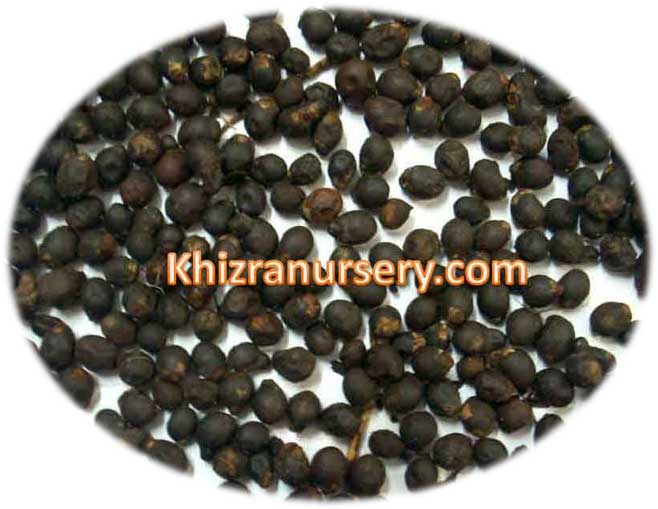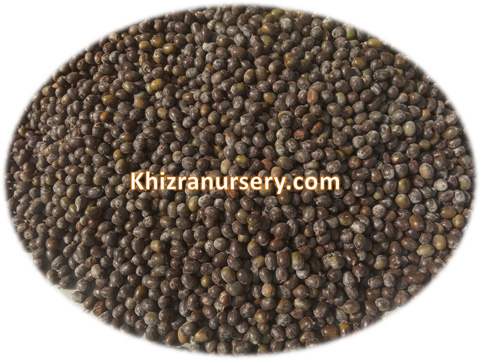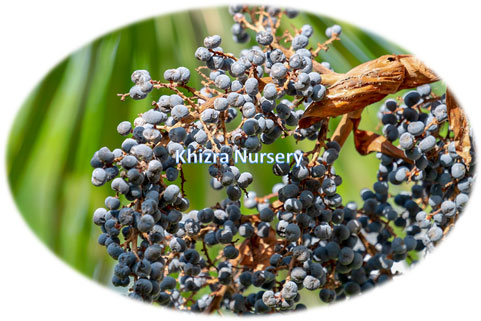Roystonea regia Seeds
Roystonea Regia is commonly known as royal cuban palm, florida royal plam and also simply as royal palm.
It is grown as decorative palm quite widely because of its attractive and hefty appearance, which makes
it quite noticeable plant in landscapes.
The Roystonea regia seeds or its fruits are dark purplish black in colour which are consume by birds and bats. The fleshy pulp of fruit is remove in order to obtain the seed. This should be done by wearing rubber gloves because the fruits pulp contain calcium oxalate crystals that are highly irritating to expose skin. The obtain seeds should be clean and store for plantation.
Roystonea regia As Oil Seeds Source
The seed of the roystonea regia royal palm is used as a source of oil and for livestock feed.
Storage of Roystonea regia Seeds
The seeds of Roystonea regia are collected from its fruits and thoroughly clean. The clean seeds can be store in a cold place for several months. They should be air dry at 80 to 90 percent relative humidity and treat them with fungicide. The seeds are place in tightly seal polyethylene containers. These seeds are keep at room temperature (23 °C). Damage and diseases seeds should be avoided while storing.
Sowing Instructions for Roystonea regia Seeds As Indoor planting
Stratification is recommended, if the seeds require stratification before planting indoor. For indoor planting, container is filled with seed mixture about half an inch from the top. Seeds should be place to 1 inch below the soil surface. Gentle water spray is use to moist the seeds. Too much water is might be harmful to seeds and will cause seed rot. The seeds germinate quite after 1 week or may take 3 months to germinate depending on the nature of specie and the environmental conditions. The containers should be place on a heat mat under 14 hours per day of constant light. Once the seeds germinate, they should be move to their separate containers under the proper light. The sprouting seedlings is keep indoor until 2 to 3 months before transplanting it outdoor. The best season for transplanting is in spring from May to June.
Sowing Instructions for Roystonea regia Seeds As Outdoor planting
If the seeds do not require stratification then the best time to plant a tree or shrub outdoor is spring. The seeds should be sow in the soil outdoors before the winters. This will naturally stratify the seeds during the cold winters and the seeds will germinate in May during spring.
How to take care of Roystonea regia Seedlings
- Soil: The seeds prefer to grow in a well-drained soil.
- Temperature: The optimum temperature for the sprouting of seed is 95˚F.
- Tolerance: The seedlings are moderately tolerant to salt spray but intolerant to high salt concentration.
- Transplantation: The seedlings should be transplant t larger containers when the second leaf emerges.
- Deficiencies: The seedlings are mostly prone to Boron (B), Potassium (K) and Manganese (Mn) deficiencies. Potassium deficiency causes tip necrosis and curling of oldest leaves. It also reduces the number of leaves. Boron deficiency causes distortion of newly emerging leaves. Manganese deficiency causes leaflet tip frizzling.
- Fertilization: Regular use of fertilizer are recommend which can prevent nutrient deficiencies in seedlings.
- Pest attack: The seedlings are susceptible to Royal palm bug (Xylastodoris luteolus). This bug is tiny, pale green and infests in newly emerging leaves. They feeds on the leaves during spring months and cause leaflets to appear chlorotic and frizzle.
- Fungal Diseases: The seedlings are also susceptible to the fungus such as Ganoderma butt rot, which is cause by Ganoderma zonatum that infects the central portion of the trunk. Another lethal fungal disease is Thielaviopsis trunk rot. This fungus requires a soft portion of trunk for infection and create a wound in the trunk. However, there is less control on fungal diseases.
Roystonea regia Royal Palm Overview
Roystonea regia is a national tree of Cuba Island and native to Cuba and South Florida. It is a spectacular palm and one of the most beautiful palm of the world. Unlike other palms, it grow rapidly if they get proper watering and fertilizer. This species can reaches to height of 50-60 ft. with the diameter of its canopy of 20-25 ft. Their straight and metal grey trunk with dark green crown shafts makes them to look elegant. It is usually occurs in the tropics and subtropics as an ornamental plant.








Reviews
There are no reviews yet.